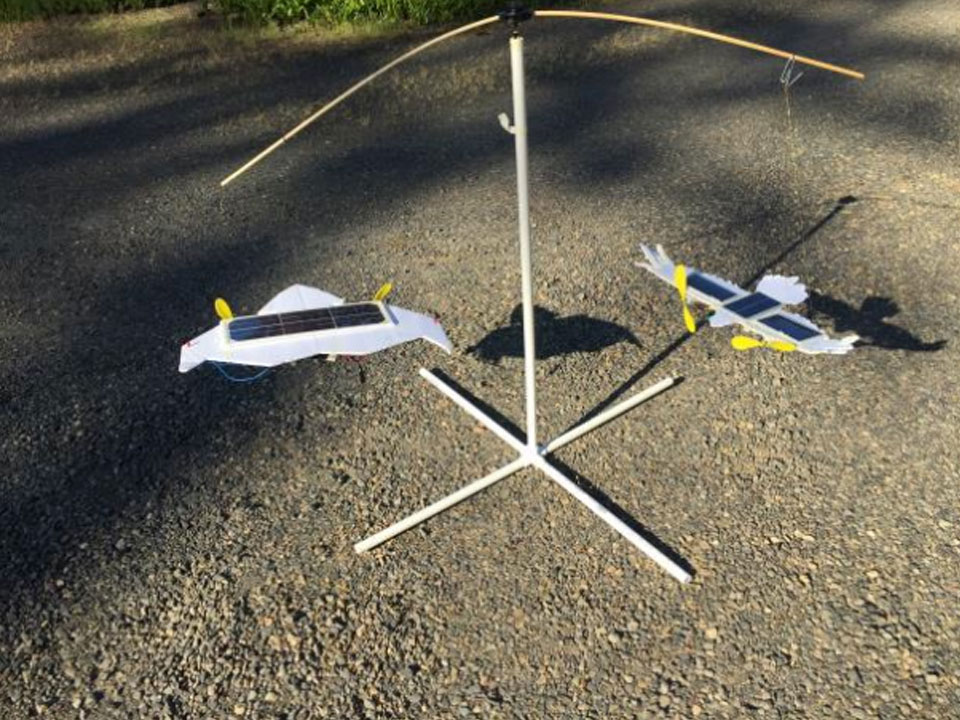Phenomena: Solar Powered Aircraft
Since manned and unmanned aircraft CAN be powered by solar, how can we power small aircrafts mounted on table top mobiles?
- Historic Flight. Solar Impulse Foundation.
- NASAs Pathfinder Solar Powered Aircraft
- History of Solar Flight, André Noth, 2008. Autonomous Systems Lab, Swiss Federal Institute of Technology Zürich
Next Generation Science Standards
Next Generation Science Standards (Table Standards) * Note there is a spacer of 15 px after this table.
| NGSS Performance Expectations | How is this Assessed? |
| MS-PS3-5 Construct, use, and present arguments to support the claim that when the kinetic energy of an object changes, energy is transferred to or from the object. | Lessons 1-3: Students will use various solar panels and learn about solar energy transfer in order to power the motors on their solar plane. Students record this knowledge and use it for their final engineering design project. |
| MS-PS2-2 Plan an investigation to provide evidence that the change in an object’s motion depends on the sum of the forces on the object and the mass of the object | Lesson 4: Students investigate the Center of Gravity using a meter stick and clay. Then they participate in an activity that works with irregular objects and finding the Center of Gravity leading up to finding the center of their irregular shaped aircraft that will be used on the solar mobile. |
| MS-ETS1-3 Analyze data from tests to determine similarities and differences among several design solutions to identify the best characteristics of each that can be combined into a new solution to better meet the criteria for success. | Lesson 5: Students record and discuss their results before, during and after the implementation of their team’s solar mobile prototype. Students justify – in a demonstration and in writing – why their solar mobile is the model that should be chosen for public display. |
| MS-ETS1-4 Develop a model to generate data for iterative testing and modification of a proposed object, tool or process such that an optimal design can be achieved. | Lessons 2/3/4/5: Students work through modifications and apply what was learned about solar circuits, the center of gravity, and irradiance as they build their final model. |
Lesson 1: Introducing the Solar Mobile Design Challenge
This lesson is aimed to engage students and build excitement for their future engineering design challenge of building the fastest Solar Powered Mobile. Through multimedia resources, Students will encounter real life solar aircrafts and a room-sized Solar Mobile. Students will then be given the scenario of designing a solar mobile for a Children’s Technology Museum with an additional challenge to articulate why their design should be chosen by the Museum’s Board of Directors to be part of the new Renewable Energy display.
Lesson 2: Exploring Circuits and Optimum Power
This lesson is an exploratory learning cycle that will give the instructor input as to where students are in their understanding of circuits and also scaffolds student learning. This lesson starts by engaging students by using an Energy Stick. Then, students start by working with small lamps and LEDs to build simple series and parallel circuits. Students then move on to testing motors with propellers and then add a battery pack to the circuit. In the end, students should build a circuit that they feel will be the best for their future mobile aircraft.
Lesson 3: Exploring Center of Gravity
Since the concept Center of Gravity (mass) is a key factor in a mobile, students will participate in some activities to help them experience and understand this principle so it can be applied to their final Solar Mobile design. This lesson starts with a teacher demonstration of the discrepant event of a bird that can balance on its beak. Then students will explore center of mass with a meter stick and balls of clay giving them some hands-on experiences. In addition, students can work with various irregular shapes cut out of file folders and find the center of mass of an irregular shape. They can follow the same process as in Center of Irregular Things and find the initial center of mass for their aircraft.
Lesson 4: Light Source Efficiency: Exploring Irradiance
This lesson explores the concept of irradiance by having students use a Vernier Pyranometer. Using the “Light Source Efficiency” worksheet to guide their work, students measure irradiance as compared to the Sun’s irradiance to see what would be the best light source for powering their solar mobile indoors. This can be done as a demonstration or at a station if you only have one LabQuest2 and Pyranometer.
Lesson 5: Solar Mobile Design Challenge – Construction
This is the culminating hands-on project for the Solar Mobile Design Challenge Lessons, with construction aligned to an engineering design process. Students start by Restating the Design Problem that was introduced to them in the beginning of the Unit. Next, they Brainstorm ideas and Plan out the construction of the mobile. Students research an aircraft to draw (if this was not accomplished in the Center of Gravity lesson) and move on to the building phase. The exciting part is pulling all the parts together to Build, Test, Evaluate, and go through this loop multiple times making improvements along the way. The final assessment will be students demonstrating how their Solar Mobile works and justifying why their mobile should be chosen for the Children’s Technology Museum.

